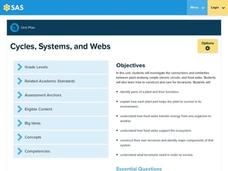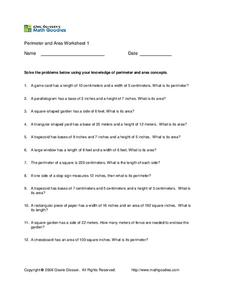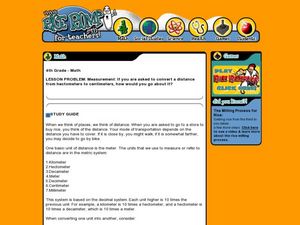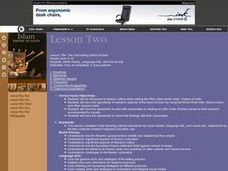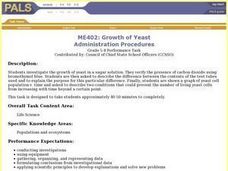Pennsylvania Department of Education
Cycles, Systems, and Webs
Fourth graders review the parts of the plant and their functions. In this plant lesson plan, 4th graders recognize that plants must transfer energy to make food. Students understand the interdependence of organisms in an ecosystem.
Curated OER
Pilots, Airplanes, and the Tangent of Three Degrees
Students explore how to use trigonometry in the aviation field. In this aviation lesson students complete trigonometry equations that show what planes should do to land their airplanes.
Curated OER
Meet One Picky Bird
Students complete a research project In this endangered species lesson, students use the "Think, Puzzle, Explore" method to learn about endangered species. Students research and write a report on the red-cockaded woodpecker.
Curated OER
The Solar System: Go Green with the Sun!
Third graders learn how to use solar power. In this sun, technology and energy instructional activity, 3rd graders learn how the solar power from the sun can give off energy, learn about solar panels, discuss their uses and benefits,...
Curated OER
The Solar System
Third graders investigate Newton's law of Motion. In this chemical reaction lesson, 3rd graders participate in an experiment with rockets to study Newton's law. Students observe the effects of a chemical reaction made by combining...
Curated OER
Proportional Representation: A Fairer Voting System?
Tenth graders work as a grade to conduct a mock election. They tally votes in two different systems and discuss if proportional representation or straight counting of votes leads to a fairer outcome.
Curated OER
What Makes Up the Solar System?
In this solar system worksheet, students will fill in the blanks for 5 statements in this graphic organizer based on the objects found in space that make up the solar system.
Curated OER
Why is Excretion Necessary for Life?
Students describe and explain the function of each part of the excretory system. They discuss how the body uses the excretory system and identify diseases of the system.
Curated OER
Reproductive Health: Friendship, Marriage, Sex
Students contrast friendships, dating, love, marriage and parenting, describe the reproductive systems and related disease prevention and define conception, contraception, abortion and pregnancy.
Curated OER
Art and the Golden Ration
Students manipulate several metric measuring devices to become competent in their use. Students work cooperatively to complete a worksheet based on the Golden Ration. Students observe example of sculptures from different cultures and...
Curated OER
Perimeter and Area
In this perimeter and area activity, 10th graders solve 12 different problems related to perimeter and area of various shapes. First, they determine the area of a parallelogram with a particular base and height. Then, students determine...
Curated OER
If you are asked to convert a distance from hectometers to centimeters, how would you go about it?
Fourth graders convert measurements in the metric system. In this metric activity, 4th graders convert units up to kilometers and down to millimeters. They answer word problems with conversions.
Curated OER
The Fascinating World of Islam
Students participate in viewing the PBS video series Islam: Empire of Faith. They research aspects of the world of Islam by using the internet and other research tools. They create, in groups, an ABC Book of Islam based on their research.
Curated OER
Introduction to World Religions - Christianity
Sixth graders explore Christianity. In this world religions lesson, 6th graders listen to a lecture about the attributes of the religion and then listen to and then conduct independent research on Christianity. Students also complete a...
Curated OER
Basic Word Problems
In this basic word problems worksheet, 6th graders solve 5 different types of word problems based on information described in each problem. First, they determine the number of books needed to read. Then, students determine the total...
Curated OER
Roman Toothpicks
Second graders make a chart comparing Roman numerals and our number system using toothpicks and construction paper. This clever lesson has students use toothpicks to create Roman Numeral translations for standard numbers.
Curated OER
Lost King of the Maya
Learners are introduced to the Mayan Long Count calendar system. They work in groups to calculate the date of their birth and use the calendar to determine important Mayan dates.
Curated OER
ME402: Growth of Yeast
Students investigate the growth of yeast in a sugar solution. They verify the pressure of carbon dioxide using bromothymol blue. Students are asked to describe the difference between the contents of the test tubes used and to explain...
Curated OER
Fairy Tails Can Show Due:It can happen for you, If you play your part.,
Learners view a Reader's Theater focusing on the story of Goldilocks and the Three Bears. The story is used as a springboard into a videotaped mock trial of Gold E. Locks developed by the American Board of Trial Advocates (ABOTA). They...
Curated OER
Cardiac Arrest! Using Forensics to Investigate Cardiovascular Anatomy and Function
Learners identify the different parts and functions of the cardiovascular system. In this forensics lesson, students collect and analyze evidence on a fictional crime. They describe different causes of cardiac arrest.
Curated OER
A Lesson To Accompany "The First Bank of the United States: A Chapter in the History of Central Banking"
Here is an interesting topic. Learners examine the economics that led to the founding of the First Bank of America. They participate in a reader's theater experience depicting the debate between Alexander Hamilton and Thomas Jefferson...
Curated OER
Thinking Spelling
An etymology resource is packed with suggestions for activities designed to build phonological, visual, morphemic, and etymological spelling skills.
Curated OER
Density Dynamics
Students set up working models demonstrating lake turnover and the formation of deep water masses in the oceans.
Utah Education Network (UEN)
Create, Classify, and Sort Quadrilaterals
Quadrilaterals can be quirky! Fourth graders use geoboards and bands to create four-sided figures. They analyze the attributes such as angle size and presence of parallel sides. As a result they learn to differentiate among rectangles,...


